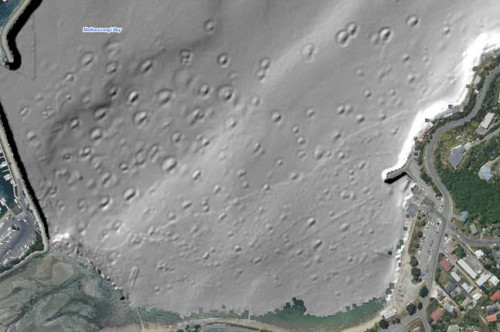Protecting the Marlborough Sounds seafloor
Protecting the precious Marlborough Sounds seafloor
Some Marlborough Sounds boaties are switching to environmentally friendly moorings to help protect the area’s precious seafloor following recommendations from an Envirolink report.
There are more than 3,000 traditional block-and-chain swing moorings for boats in the Marlborough Sounds that can destroy sensitive seabed habitats that have taken years or decades to form. The block crushes anything that was living under it, while the chain can sweep around in a circular motion - eventually destroying and killing everything within its reach.

Scours from block-and-chain moorings are shown as circular marks in this image that looks down on Waikawa Bay, Marlborough Sounds.
With funding from the Envirolink Scheme, Marlborough District Council (MDC) commissioned Cawthron Institute to analyse the ecological effects of different types of swing moorings and recommend where it would be better to use more environmentally sensitive systems.
The resulting 2018 report(external link) provided guidelines for MDC when assessing mooring consent applications. A number of these guidelines, including considering a mooring’s suitability, have been incorporated into the Proposed Marlborough Environment Plan (PMEP) that should be finalised in early 2020.
In the meantime, partially in response to the Envirolink report’s recommendations, MDC is already successfully encouraging boaties to switch to more environmentally friendly moorings.
Between early 2018 and November 2019, MDC granted resource consents for 31 new moorings, of which about 40% were for elasticated or similarly designed moorings, says Senior Resource Management Officer Peter Johnson.
“Dozens more mooring owners throughout Queen Charlotte Sound/Tōtaranui have agreed to upgrade their moorings within the next 10 years to an elasticated or similar design, largely following requests to do so from Te Ātiawa o Te Waka-a-Maui (a local iwi),” he says.
“The EnviroLink report has been one of several catalysts to bring about a better understanding of, and a better approach to, mooring practices in the Sounds. The other key factors are the data and images gained from our seabed habitat mapping project, requests from Te Ātiawa o Te Waka-a-Maui and the objectives and policies in the PMEP.”
MDC Coastal Scientist Oliver Wade says it’s vital to protect the seafloor because of the critical part it plays in marine ecosystems.
“The seafloor is literally the foundation of the marine ecosystem. It’s often home to algaes and reef building species that form fragile three-dimensional structures called biogenic habitats. These provide refuge for many animals, opportunities for spawning areas, nursery areas, feeding areas and are often critical to different life stages of many species.”
Last modified: